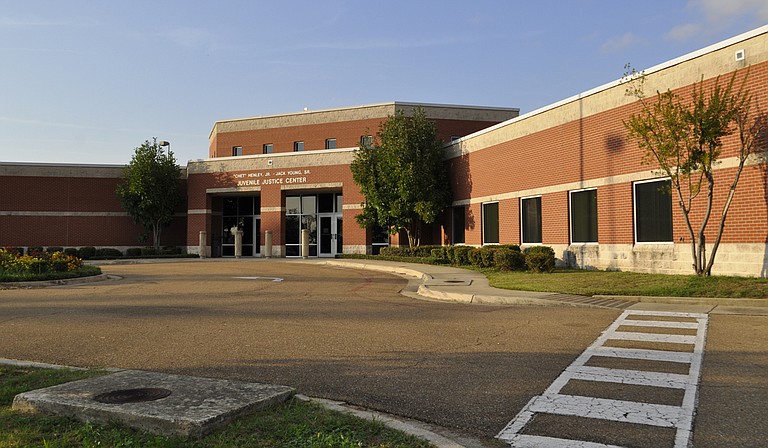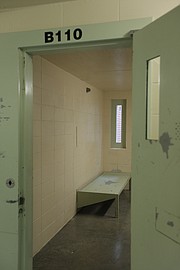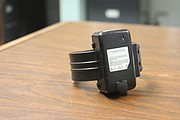The Hinds County Henley-Young Juvenile Justice Center has been the subject of lawsuits, reforms and face-lifts in its struggle to address the roots of juvenile deliquency and crime. Trip Burns/File Photo
Wednesday, December 14, 2016
Across the pod, from inside the darkness of a cell, two shining circles stared out: the still and steady eyes of a black boy, locked up before he is even a man.
His cell is on the lower floor of the pod, one of four in Henley-Young Juvenile Justice Center. Each pod holds 32 kids in individual cells. Johnnie McDaniels, the executive director of the Henley-Young Juvenile Justice Center, pointed to the chain-link fence of the top floor, sections of which he ordered covered in Plexiglas.
The children leapt from the stairs to the outside of the barrier, McDaniels said, hanging on and climbing around the three-sided room to the frustration of the detention-center staff. After all, they are kids, not adults, and Henley-Young is not a jail.
Holding cells built 20 years ago now sit unused, with yellow and green covering the drab gray paint of yesteryear. The visitation room, a movie-set telephone-through-the-glass set-up, is vacant. Now children meet with their parents in an activity room, under a mural that the kids painted. It feels like a daycare run in an old jail.
Thanks to a federal court order, the building reflects steps by leaders like McDaniels to ensure the facility is not merely a waiting room for adult prison or jail. Toward the end of the tour, McDaniels put his hands up and, with a smile, summed up how far Henley-Young has come.
"Not. A. Dungeon," McDaniels said, laughing, his voice echoing in the empty lobby.
If it isn't one now, it certainly used to be. Just as the facility has changed in appearance, so has the approach of some state detention directors to juvenile justice. Research shows that traditional detention is simply not working as a deterrent to youth crime—and can actually increase it.
In 2015, 10,187 young people from age 7 to 18 were referred to a youth court for a delinquent act. The agencies and people capable of referring these kids include law enforcement, family, schools, socials services, medical or mental professionals and Department of Youth Services or court representative.
The total number of referrals to youth court for the entire state was 18,674.
Some of the children referred to the youth court returned more than once, resulting in 13,388 cases that passed before a youth court or similar set-up in Mississippi during 2015, annual reports from the Division of Youth Services in the Department of Human Services show.
The state's numbers have dropped significantly since 2008, the annual reports show. In 2008, more than 18,500 youth were referred to youth court—today that number is closer to 10,000. The data are not absolute, however, and in reports from 2013-2015, hundreds of youth are "miscoded," meaning they weren't properly recorded and so were not counted.
The racial disparities in Mississippi's juvenile-detention system are vast and have not changed much in almost a decade. Since 2008, more than 60 percent of children referred to youth court for delinquent acts are African American. That percentage remains the same today.
Administrators, county and special-interest groups have chipped away at antiquated practices to make room for rehabilitation and therapy. These efforts attempt to address the core issues that culminate in youth crime, delinquency and recidivism, in Hinds County and across Mississippi.
'Prison-like Environment'
Several interest groups filed a lawsuit in 2012 on behalf of unnamed juvenile offenders who spent time in Henley-Young, citing poor conditions in the facility. Disability Mississippi and the Southern Poverty Law Center settled with the county in an agreement known as a federal consent decree, which included 71 points of improvement that the administration had to meet within four years.
"That's one of the things that I emphasize as a director here, that Southern Poverty (Law Center) and others did a good thing by pointing out some issues, but I think it's the responsibility of directors in places that are going to have the facilities to provide those resources," McDaniels said.
The court recently approved extending the agreement because the county still needs to improve its practices in mental-health care, nutrition, and family support and interaction.
The federal judge assigned monitor Leonard Dixon, who is based in Missouri, to review and report on the facility's progress. Dixon submits regular reports to the court, ranking Henley-Young on a four-step scale from non-compliance to substantial compliance.
"The facility is not pleasing in appearance and has a dungeon-like feeling," Dixon wrote in 2012. "Henley-Young's prison-like environment works against its programming, treatment, and rehabilitative objectives due to its hard, sterile and depressing atmosphere."
In an Oct. 3 interview, Dixon said the detention center's purpose is widely misunderstood. "I think one of the problems is that, not just in Henley-Young, is we have tried in this country to 'adultify' the juvenile-justice system," Dixon said. "Our job in juvenile justice is more complicated than adult detention."
"This is a juvenile-justice system, not a baby adult system," Dixon said.
He said kids tend to be angrier than adults, and more impulsive. Their decision-making, muddied by immaturity and growth-related issues, lacks the understanding of consequences most adults have.
"That's why you spend a lot of time with them, because they are not mature enough to understand the consequences of their behavior," Dixon said.
"That doesn't mean that there are not consequences for their behavior. There's a difference."
Altering the approach to children in jail involves change from decision-makers who prefer detention. "The community has to say that we are going to treat our kids as people, that we don't see them as little adults," Dixon said.
Problems outside the reach of the justice system, such as family issues, Dixon said, can lead parents, teachers and others to support detention over rehabilitation as a quick, punitive fix to a long and complicated problem. It isn't.
"The first thing that happens is, we say let's lock them up, that's going to resolve the issue," Dixon said.
"But if that's going to resolve the issue, shouldn't we have less kids in detention?"
'Trying to Get to an A'
Now, four years and several directors later, McDaniels walks through the detention center pointing to improvements, like the paint. In his Jan. 27, 2016, report, Dixon listed the facility as in non-compliance with 26 out of the 71 points, an improvement over previous years.
The 71 points cover every aspect of Henley-Young, from aesthetics to when to handcuff the children.
One of the most important changes since McDaniels took over is the court-ordered reduction in the number of children housed in Henley-Young and for how long. Dixon's report stated that the facility did not provide enough staff to care for the population of children, much less the maximum capacity of 84, when the federal court first approved the consent decree. Today, the facility has a limit of 32 children, matched to the level of funding available. Before, according to Dixon's reports, the detention officers would be stretched thin, leaving some children locked up in their cells for hours because the staff could not control them in such large numbers.
Now, McDaniels said, the numbers barely reach the 30s on a daily basis.
Henley-Young also upgraded its technology, installing a full-facility surveillance system. Eddie Burnside, director of operations at Henley-Young, explained that the addition of digital surveillance adds another layer of safety. Now, the nerve center of the facility includes 54 cameras on a large flat-screen monitor showing every room.
"This is like the brains of the facility," Burnside said. "Wherever we have kids present, (the worker) can pull it up and see them."
The facility's administrators use the intercoms to speak directly to the area they wish, and the radios to communicate with detention officers throughout the facility. On this day, the cameras showed children outside doing pushups on the basketball court, some in an activity room in the center of the facility and several empty rooms.
The cameras follow the children everywhere, starting from their admittance in a booking area not unlike those found in county jails. A wide, deep desk sits facing a ring of holding cells, which McDaniels and Burnside said are now never used.
When admitting the children, Henley-Young staffers ask if they require health care, administer them mental-health evaluations and lead them back to begin the orientation process. The children sit down at little cubicles next to the booking desk, filling out the survey in an officer's presence.
If any of the children score high enough on the mental assessment—itself an improvement since early monitor's reports—to need services, Henley-Young staffers separate them from the group for constant observation until they can get mental-health attention. In general, kids take the 15-minute test seriously, Burnside said, because they know a high score means more staff attention, and possibly a longer stay, which most in his experience want to avoid.
"Slowly but surely, we are moving away from a punishment-type system here, but that is another battle for another day," McDaniels said, adding that the consent decree allows him and his staff to apply national standards to Henley-Young.
For instance, the county built Henley-Young with a jail-style visitation room, but now the children meet with their parents in the main activity room, where the child and parent can touch and talk. Such important and soothing aspects contribute to healthy rehabilitation, he said.
Some physical facility aspects are unavoidable. Each tiny cell has bare cinder-block walls with a miniscule window and a matching mini-bed. Twin concrete blocks jut out from the wall and together form a rudimentary desk. An adult male's body fills the cell, similar to the adult county jail in Raymond.
McDaniels' solution to keep the children out of the cells is a long day full of activities. On the day of the tour, a deluge of rain interrupts the play outside on the basketball court. McDaniels said he asked the Hinds County Board of Supervisors for a cover for the court at a recent update meeting. He is hopeful he can secure more funding for the facility in upcoming years.
Poor nutrition is a common problem the children bring to detention. McDaniels touts the "B" rating the kitchen received, adding that the children receive free meals and snacks while there.
"Our breakfast, lunch and dinner program is actually certified, so I actually get money back," McDaniels said, adding that providing higher-quality meals has made the facility $26,000 so far since he took over. "We are trying to get to an A."
"This was a big thing, to make sure that the kitchen was cleaned," he said.
Room to Improve
McDaniels readily admits the facility and its operations both still need improvement. For instance, although Jackson Public Schools runs the Henley-Young school, providing a comparable education to what the children left when detained poses a constant problem. Detaining children contributes to their inevitable inability to keep up with their peers when they are released. This delay increases chances the child will continue to cycle in and out of the facility.
"Your education has to maintain itself," McDaniels said. "You can't come from a regular school setting and come into a detention-school setting and somehow miraculously you are going to keep up to the degree that you can leave here after 90 days and keep going. You are probably going to be behind, and then you are going to end up quitting, and that is the last thing you want a kid to do."
Coming soon are three full-time case managers, set to occupy offices directly adjacent to the pods. McDaniels said the case managers will follow the children through the juvenile-justice system, assisting with mental-health or substance-abuse therapy, satisfying the consent decree.
The county recently approved an influx of money, a budget shift of $190,000, to set up a full-time mental-health staff, moving the funds from the youth court, for one year. McDaniels said the new case managers will help the two workers they have on staff now, as well as move the center closer to consent-decree compliance.
While the county did shift funds, the move from another department—in this case the youth court—during tightening government budgets makes asking for more financial resources difficult. This year McDaniels had the consent decree and a federal order behind him, but a new U.S. president means uncertainty over whether the center can count on federal support, whether legal or through grants.
"In this age of austerity that not only engulfs Mississippi but across the country, the commitment to providing social services just has not been on the radar," McDaniels said. "The answer to that is no, the funding is not always there."
Facing tighter budgets every year, Henley-Young may need to look to other programs in the state for solutions, starting with the country next door.
Rankin 'Wraparound'
If it weren't for the tall fences, you could mistake the Rankin County Youth Detention Center for one of the newer schools in Madison County, like Ridgeland High School and its architectural copy-cat, the high school in Gluckstadt.
Inside, the center's administrative offices are modern and polished, but the stone floors leading to where it detains kids are an unfriendly gray. Laminated posters on the blue walls remind the children of the center's expectations for behavior.
Rankin County has been using this building since September 2011; the original center in Pearl suffered from structural issues. Before it constructed its first detention center, the county shipped children to Lauderdale County.
"The county was growing rapidly at the time, and the county thought it best to have a facility where its children could be housed locally, and the kids could be near their parents and their school systems, and also have the ability where they could have their probation officers and counselors and court staff nearby," Youth Court Judge Thomas Broome said at the center.
In this Pelahatchie building, Broome works out of the youth court attached to the actual detention center. A Mississippi State alumnus, Broome keeps a Bully the Bulldog mask beneath his bench and tries to keep kids out of youth detention as much as possible by helping provide them with mental-health services. Still, for those kids in need of detention, he said, it's beneficial to have the facilities near their homes.
"It's important that the family stays involved with the child and visits on a regular basis, and being close in the community helps that because transportation is often an issue for some of these folks," Broome said.
The local facility also fosters community engagement.
"It allows for the community to serve as a wraparound by being involved with the children," he said, adding that community members can praise the children for positive behavior they observe.
"If you have a kid who's connected with the place they're from, then it gives them better grounding so they don't want to do anything to cause harm to themselves or cause harm to the community," he said.
The facility gets no money from the State, save from the Department of Education. The Rankin County Board of Supervisors provides the primary funding stream—meaning the county's taxpayers foot the bill. But Rankin County has the second highest per-capita income in Mississippi, 2010 census data show, and the investment in the youth detention center pays off. It partners with REACH Mississippi, which also funds facility-wide PBIS program—a "positive behavior interventions and supports" systems that focus on rewarding successes over punishing over mistakes. That alliance contributes to Rankin County's status as a model detention center in the state, with a low rate of recidivism, or re-offending.
For Henley-Young, setting up such a program faces the same obstacle as other parts of the facility: a lack of consistent leadership. Three detention-school principals served at Henley-Young in the last four years, a January report states.
Dixon retained Carol Cramer, an expert in education in youth detention, to study the center. She said in a report that Jackson Public Schools should install a permanent administrator.
"The constant change in leadership in the school program has had a negative impact on the ability of the school program to make progress on the recommendations in the compliance reports or toward best in general," Cramer wrote.
"Constantly changing leadership means the administration and staff is always having to adjust to a new leadership style and philosophy and never getting to address the issues at hand, i.e. the compliance requirements or the issues that are keeping the school program from excelling."
Avoiding Police Cars
The crepe myrtles surrounding the Adams County juvenile-justice building were in full bloom last summer, a lasting remnant of community-service work that the youth court judge there assigned to kids instead of locking them up inside it.
On a single day in July, only two of the 13 kids inside were from Adams County, a testament to the county's work to keep kids out of detention and in their communities instead. The work comes from what the juvenile-detention center's administrator Henry Upshaw calls "synergy" among his staff, the youth court led by Judge Walt Brown and local law enforcement officials.
The youth court there uses alternatives to detention from electronic monitoring to drug courts to community service to keep kids out of detention as much as possible, an effort both Brown and Upshaw support in the southwest Mississippi county.
"So there's a statistic that kind of hit me in the face when I heard it: just by putting a kid into the back of a police car, that drops his likelihood of graduating high school by 50 percent, so we try to avoid at all if we can," Upshaw said.
Electronic monitoring, which means using thick ankle bracelets to track and monitor a kid's whereabouts, is largely to thank for the county's major drop in detaining kids in the past few years.
On July 12, Upshaw listed eight kids from Adams County who wore ankle bracelets, monitored electronically. Upshaw can open the monitoring phone app and can scroll through the list of names of kids with bracelets. Once he clicks on a name, he can see their current location and every morning when he gets in to work, he can print out their path from the day before.
Both Brown and Upshaw admitted that the kids do not like the ankle bracelets. The court can use bracelets on a scale, what Upshaw calls "graduated sanctions." The lowest level, Upshaw said, is when he puts the bracelet on the kid but does not activate it, so it is not actually doing anything. The next levels range from tracking to house arrest. Judge Brown will use electronic monitoring as both an alternative to detention before and after a kid is picked up. Brown also assigns community service regularly as a punishment, if a child is found guilty.
The Adams County Juvenile Detention Center remains open because, Judge Brown said, his predecessor Judge John Hudson showed the county how much money it would save keeping the juvenile-detention center open. It is costly to send kids across the state to another county like many counties around the state do.
Not all counties in the state have a juvenile-detention facility, and consequently must send their kids sentenced to secure detention to one of the state's other juvenile detention centers. For example, Lee County Juvenile Detention Center serves 21 counties in the state, besides housing their children, their administrator Lt. Ronnie Partlow said during a phone interview.
Adams County charges other counties around $110 per day to hold a child in secure detention, not including costs for counties to send their kids to Adams County, back for their court hearing, and then back again (if found guilty of something that warrants detention).
"Alternatives to detention save money whether you're housing them in your county or whether you're transporting them to another county," Upshaw said. "The pressure was on to close down the center, but when we went through and crunched some numbers, and we showed them how much it was going to cost to transport a child three times, (that changed)."
Part of what Upshaw believes is different about his staff and the system in Adams County is that everyone cares.
"If the state has to make me care about the kids, I'm in the wrong business," Upshaw said. "Nobody from the state should have to make me come and care about these kids; I care about these kids, whether their rights are being violated or not."
Similarly, Judge Brown found himself down at the courthouse on a Saturday during his first week on the bench, checking on a young man who had shown suicidal tendencies. "That's my biggest fear," he said.
In juvenile detention, vigilance is vital. Upshaw told stories of getting notifications from his phone app that "Joe" was out of his zone. Often, Upshaw either calls Joe through his ankle bracelet and speaks to him that way or drives over to tell him to go home himself—without ever involving law enforcement.
Even before a child is sent to youth court in Adams County, the law enforcement officer or the probation counselor completes a risk assessment, a one-sheet paper checklist that scores the offending child. Based on that score, the child receives a different juvenile-justice experience.
Upshaw said the risk assessment helped change the strategy for law enforcement and probation officers alike.
"What we have found is that changing the culture in the building, they already know that we aren't going to bring certain kids into detention," Upshaw said. "They are learning that things have changed. Judge Hudson started that, and ... once the culture changed, now it's pretty much a matter of maintaining that atmosphere."
Reform, Reinvest, Repeat
Comprehensive reform is admittedly easier when state law and dollars dictate how juvenile-detention centers work instead of counties. In Georgia, advocates for juvenile-justice reform, eventually followed by the governor and lawmakers, discovered this to be true when they overhauled the state's juvenile-justice laws in 2013, shifting funds to alternative programming.
The 2013 Georgia legislation reinvested funds used to hold non-violent offenders to youth courts to develop alternative programming and clarified separate classes of felonies to ensure that kids are not locked up for most non-violent offenses.
Georgia's juvenile-justice system badly needed reform, with a recidivism of over 60 percent before 2013, Melissa Carter, director at the Baron Child Law and Policy Center at Emory Law School in Atlanta, said.
Carter says her team worked on reforms for a decade before Georgia Gov. Nathan Deal added criminal-justice reform to his agenda—which tied easily to juvenile-justice reform. Georgia's 2013 law created a "Child in Need of Services" category, designating children who commit status offenses, which are offenses unique to children like truancy or running away, as ineligible for secure detention for over 24 hours before and after their hearing.
Instead, the law requires these children, called CHINS, to receive services like family or individual counseling or therapy in the least restrictive environment possible, ideally allowing the child to receive services and continue to live at home. Carter says this shift put the burden back on the community to help the courts provide some of the services these children needed.
Judge Steven Tseke in Clayton County, Ga., said the reinvestment part of the new law, which went into effect in 2014, worked like grants for county youth courts around the state. The state allocated additional funding plus the money the state saved by releasing nonviolent child offenders and gave those funds to youth courts to spend on alternatives to detention.
Carter said it had cost the state close to $90,000 annually for the state to keep one child in secure detention.
"The governor directed that money to a juvenile-justice incentive grant that goes back out to communities to allow them to create evidence-based programs and community-based alternatives to detention, like family therapy," Carter said.
Those alternatives serve kids who are considered medium- to high-risk offenders. Tseke's court had been a Juvenile Detention Alternatives Initiative site, like Adams and Rankin Counties in Mississippi, since 2003 and had already reduced its detention numbers by 43 percent. The new money meant Tseke and his staff would need to take another look at their data to determine how they could reduce their numbers again.
Tseke got his IT team to survey the data and found out that 54 percent of the kids his court committed were primarily there due to family dysfunction, so he directed the state money to family therapy.
Since then, Clayton County's commitments to state juvenile-detention centers are down 76 percent compared to before Tseke started reforming the county's system.
Open data is the integral part of Georgia's reforms. The state's judicial council is almost done constructing the Juvenile Data Exchange portal, which will make data from the state's juvenile detention centers and youth courts open to judges and lawyers, and to some extent, the public as well. Georgia officials were able to collect the detention-center data easily due to state control and oversight of their detention centers, something Mississippi lacks.
Mississippi law directs counties to not only pay for but also administer the state's juvenile-justice system, with the exception of the Oakley Training School, the state's psycho-educational program where youth court judges send their most serious offenders, which is run by the state Department of Human Services. Mississippi lawmakers passed the Juvenile Detention Facilities Licensing Act in the 2016 session to ensure that detention facilities around the state are licensed. The bill mandates that the Juvenile Facilities Monitoring Unit, housed in the state's Department of Public Safety, conduct assessments of juvenile-detention centers, and license them accordingly.
The Mississippi Department of Public Safety division of Public Safety Planning cannot require the county facilities to collect data, however, the new executive director Ray Sims said in an emailed statement, because they do not use state funds to operate. The central data collection system in Mississippi, called MYCIDS, is a mess, various lawyers and juvenile court administrators told the Jackson Free Press throughout the last year.
Tseke said that even though counties hold the juvenile-justice power in Mississippi, the State could force the local court's hand—but that will take leadership, like Georgia had in their governor.
Gov. Phil Bryant has continued to sign juvenile-detention facility reform legislation, from passing the bill that created the task force back in 2014 to the licensing act this year. However, no legislative or executive leaders have introduced legislation to shift funds or promote alternatives.
A statewide task force, composed of stakeholders like judges and detention-center administrators from around the state, continues to meet and chip away at reforms outside the legislative realm.
'Intense and Sustained'
As Georgia and other Mississippi counties show, changes in juvenile justice continue to happen, at the moment mostly in the hands of the administrators who are wielding federal orders or walking hand-in-hand with their youth courts.
Now, four years and four directors later, Henley-Young is making some progress, but without all the elements that make other facilities in the state as successful.
Dixon said he has monitored some facilities under consent decrees for decades, others for four years.
"It has a lot to do with how the system moves, the funding, the politics, all of those things play into this," Dixon said.
"So it's not simple. Do people have a clear direction of where you are going, do they have a clear idea? Some people don't think they need help."
Even when facilities, administrators and county leaders know they need help, as they seem to in Hinds County, they can reach a ceiling at the state level for funding without judicial support, McDaniels said.
Hinds County Youth Court Judge William "Bill" Skinner filed a lawsuit this fall, attempting to prevent the Hinds County Board of Supervisors from moving funding for the case managers from his youth-court allocation to Henley-Young instead. The court ruled against him.
Skinner has not returned several phone calls over recent months for comment.
"The mental-health services and the substance-abuse services, I think that's the responsibility of the Legislature and the responsibility of the courts to push for that, especially the judges that deal with this stuff on a daily basis," McDaniels said.
"And that's just something they have to push the Legislature on. We have to have alternative programs for juveniles."
Other places, McDaniels added, put their resources into services rather than detention. "That's not where we are here. We are still on a put-them-in-detention-first mentality," he said.
A Solutions Journalism Network grant supported this work. Read the full and ongoing series at jfp.ms/preventingviolence. Email comments to [email protected].







Comments
Use the comment form below to begin a discussion about this content.
Sign in to comment
Or login with:
OpenID